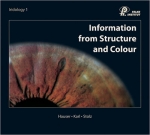On 264 pages, Willy Hauser, Josef Karl, and Rudolf Stolz explain the topography, constitutions - disposition - diathesis, structure markings, and pigments of the eye in an easily understandable way, based on the new regulations of 1996-1997.
Specifications:
264 pages, 10“ x 9“, high-quality art paper, special sturdy dirt-repelling binding,
hard cover, all pages sealed with protective varnish. Printed in Germany.
€ 98,- plus shipping costs per book:
€ 21 within postal Europe / € 34 outside postal Europe).





